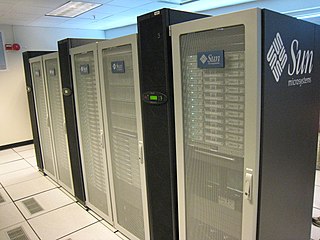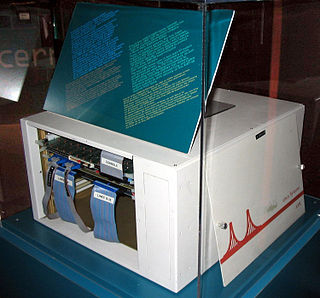FidoNet is a worldwide computer network that is used for communication between bulletin board systems (BBSes). It uses a store-and-forward system to exchange private (email) and public (forum) messages between the BBSes in the network, as well as other files and protocols in some cases.
Simple Network Management Protocol (SNMP) is an Internet Standard protocol for collecting and organizing information about managed devices on IP networks and for modifying that information to change device behavior. Devices that typically support SNMP include cable modems, routers, switches, servers, workstations, printers, and more.

Scalability is the property of a system to handle a growing amount of work by adding resources to the system.
In computer science, distributed shared memory (DSM) is a form of memory architecture where physically separated memories can be addressed as one logically shared address space. Here, the term "shared" does not mean that there is a single centralized memory, but that the address space is "shared". Distributed global address space (DGAS), is a similar term for a wide class of software and hardware implementations, in which each node of a cluster has access to shared memory in addition to each node's non-shared private memory.

In computing, a visual programming language (VPL) is any programming language that lets users create programs by manipulating program elements graphically rather than by specifying them textually. A VPL allows programming with visual expressions, spatial arrangements of text and graphic symbols, used either as elements of syntax or secondary notation. For example, many VPLs are based on the idea of "boxes and arrows", where boxes or other screen objects are treated as entities, connected by arrows, lines or arcs which represent relations.

NetApp, Inc. is a hybrid cloud data services and data management company headquartered in Sunnyvale, California. It has ranked in the Fortune 500 since 2012. Founded in 1992 with an IPO in 1995, NetApp offers hybrid cloud data services for management of applications and data across cloud and on-premises environments.
HP OpenView is the former name for a Hewlett-Packard product family that consisted of network and systems management products. In 2007, HP OpenView was rebranded as HP BTO Software when it became part of the HP Software Division. The products are now available as various HP products, marketed through the HP Software Division.
Grid MP is a commercial distributed computing software package developed and sold by Univa, a privately held company based primarily in Austin, Texas. It was formerly known as the MetaProcessor prior to the release of version 4.0, however the letters MP in Grid MP do not officially stand for anything.
High-availability clusters are groups of computers that support server applications that can be reliably utilized with a minimum amount of down-time. They operate by using high availability software to harness redundant computers in groups or clusters that provide continued service when system components fail. Without clustering, if a server running a particular application crashes, the application will be unavailable until the crashed server is fixed. HA clustering remedies this situation by detecting hardware/software faults, and immediately restarting the application on another system without requiring administrative intervention, a process known as failover. As part of this process, clustering software may configure the node before starting the application on it. For example, appropriate file systems may need to be imported and mounted, network hardware may have to be configured, and some supporting applications may need to be running as well.
Veritas Cluster Server is a high-availability cluster software for Unix, Linux and Microsoft Windows computer systems, created by Veritas Technologies. It provides application cluster capabilities to systems running other applications, including databases, network file sharing, and electronic commerce websites.

Oracle Solaris Cluster is a high-availability cluster software product for Solaris, originally created by Sun Microsystems, which was acquired by Oracle Corporation in 2010. It is used to improve the availability of software services such as databases, file sharing on a network, electronic commerce websites, or other applications. Sun Cluster operates by having redundant computers or nodes where one or more computers continue to provide service if another fails. Nodes may be located in the same data center or on different continents.
Apache Hadoop is a collection of open-source software utilities that facilitate using a network of many computers to solve problems involving massive amounts of data and computation. It provides a software framework for distributed storage and processing of big data using the MapReduce programming model. Originally designed for computer clusters built from commodity hardware—still the common use—it has also found use on clusters of higher-end hardware. All the modules in Hadoop are designed with a fundamental assumption that hardware failures are common occurrences and should be automatically handled by the framework.
A cluster manager usually is a backend graphical user interface (GUI) or command-line software that runs on one or all cluster nodes .The cluster manager works together with a cluster management agent. These agents run on each node of the cluster to manage and configure services, a set of services, or to manage and configure the complete cluster server itself In some cases the cluster manager is mostly used to dispatch work for the cluster to perform. In this last case a subset of the cluster manager can be a remote desktop application that is used not for configuration but just to send work and get back work results from a cluster. In other cases the cluster is more related to availability and load balancing than to computational or specific service clusters.
The Red Hat Cluster includes software to create a high availability and load balancing cluster. Both can be used on the same system although this use case is unlikely. Both products, the High Availability Add-On and Load Balancer Add-On, are based on open-source community projects. Red Hat Cluster developers contribute code upstream for the community. Computational clustering is not part of cluster suite, but instead provided by Red Hat MRG.
This is a comparison of notable free and open-source configuration management software, suitable for tasks like server configuration, orchestration and infrastructure as code typically performed by a system administrator.

In computing, Puppet is an open-core software configuration management tool. It runs on many Unix-like systems as well as on Microsoft Windows, and includes its own declarative language to describe system configuration.

oVirt is a free, open-source virtualization management platform. It was founded by Red Hat as a community project on which Red Hat Enterprise Virtualization is based. It allows centralized management of virtual machines, compute, storage and networking resources, from an easy-to-use web-based front-end with platform independent access. KVM on x86-64 and PPC architecture are the only hypervisors supported, but there is an ongoing effort to support ARM architecture in the future releases.
JACK Intelligent Agents is a framework in Java for multi-agent system development. JACK Intelligent Agents was built by Agent Oriented Software Pty. Ltd. (AOS) and is a third generation agent platform building on the experiences of the Procedural Reasoning System (PRS) and Distributed Multi-Agent Reasoning System (dMARS). JACK is one of the few multi-agent systems that uses the BDI software model and provides its own Java-based plan language and graphical planning tools.
Juju is an open source application modeling tool developed by Canonical Ltd. Juju focuses on reducing the operation overhead of today's software by facilitating quickly deploying, configuring, scaling, integrating, and performing operational tasks on a wide choice of public and private cloud services along with bare metal servers and local container based deployments.
In computing, Ansible is an open-source software provisioning, configuration management, and application deployment tool. It runs on many Unix-like systems, and can configure both Unix-like systems as well as Microsoft Windows. It includes its own declarative language to describe system configuration.








